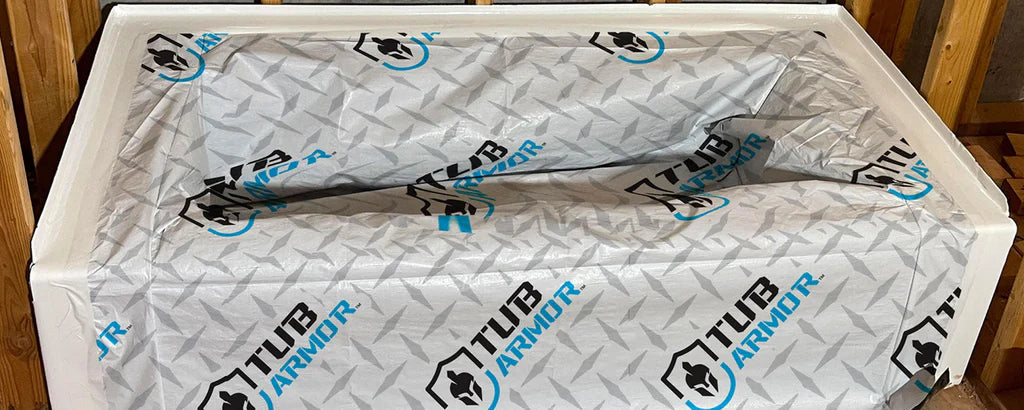
Bathtubs play a crucial role in construction projects, demanding careful concern for their protection. They have become a fitting about which multiple trades navigate during the project's lifecycle, installed before drywall, flooring, or other finishing touches during domestic bathroom remodelling. They ensure their widespread protection from production damage.
Selecting the appropriate installation methods can be daunting. You can get a wide range of products that have become a standard tool to provide protection and peace of mind with all the projects, such as:
- 30x60 Standard Tub Armor
- 30x60 Tub Combo REUSE Kit
- 36x60 Tub Combo REUSE Kit
- 36x60 Wide & Deep Tub Armor
- Armor Tape- 2.83" X 32.8'
- Bulk Armor Tape 2.83" x196.85'
This blog post shares some of the most reliable ideas for applying a bathtub protector like a pro to avoid expensive faults that can take a significant amount of time.
The Significance of Tub Protection
Tubs are vulnerable to multiple issues in construction projects, which can badly affect their durability and aesthetic appeal. You need to protect their installation and reduce expensive repairs and replacements.
Keep in mind that repairing a tub will not restore its old state and is also prone to cracks and water damage. To eliminate these problems, you can use a bathtub protector during the construction, which removes long-lasting damage and maintains its pristine condition.
Installation Process for Armour Bathtub Protection Cover
Entrust your projects with reputable experts from Tub Armor that leave no stone unturned for temporary surface protection. They do not just provide tub protection but live and breathe it. They have executed various projects following a systematic approach from the start to the finishing touches.
- Determine the issue through assessment.
- Pick the right gear for the job
- Follow the guidelines during installation
- Keep an eye on protection
Alternatives to Plywood for Bathtub Protection
Plywood has become a fundamental option for short-term surface protection. It ensures multiple things, such as:
- Durability & Strength
- Readily Available
- Movement = Damage
- Handling & Installation Difficulties
There is a variety of alternatives for bathtub protection. You can adapt these options and can save money, time and effort:
- The Armour Bathtub Protection Cover is lightweight, reusable, and easy to install.
- Bathroom Tub Protection Liner is a standard tub-like glove that ensures protection and is a breeze to install.
- For hard surfaces, the Armour Multi-Use Protection Tape is thick and great against scuffs and scratches.
- Armour Liquid Mask protects against scratches, paint, drywall mud, etc., and sticks well on non-porous surfaces.
- Armour Protection Board – Translucent, a 2mm thick, lightweight, durable sheet that fits perfectly for multi-family construction projects.
Tips for Guaranteeing Tub Protection During Construction
Use Non-Slip Floor Coverings
Rubber or foam mats must be placed to avoid slipping during demolition. For that purpose, you must choose a lining that contains vinyl, rubber, or foam and provides a strong grip. Waterproof tape prevents tripping and curling and secures runners in position.
During renovation projects, it is practical to put non-slip bath mats inside the tub whenever you step into it. Remove loose rugs before starting work, as they may slide underneath your foot. Maintain a dry surface during the entire construction project.
Keep the Area Well-Ventilated
Proper ventilation eliminates chemical vapours from the bathroom space. It is best to keep the windows open for circulation or use exhaust fans to pull out dust or other particles.
You can also wear respirator masks when working closely with demolition and take frequent breaks to get fresh air.
Use Protective Gear When Handling Chemicals
Multiple dangerous chemicals can be infused into the air during construction. You need to wear safety goggles, gloves, and masks.
You should read the warning labels. Using a chemical mixture can produce poisonous gases that can damage your health. So, do everything possible to work in well-ventilated places and use good ventilation to prevent burns or inhalation problems.
Prevent Accidents Using Secure Tools and Equipment
If not used properly, tools and heavy machinery can lead to major injuries. Using lanyards to secure the cords of power drills, sanders, and other hand tools when working from a ladder or scaffold. You can also guarantee that no one leaves an electric saw on an unfinished surface.
Designate particular storage areas for tube materials and plumbing supplies to prevent them from causing tripping hazards and ensure accessibility during floor refurbishment.





